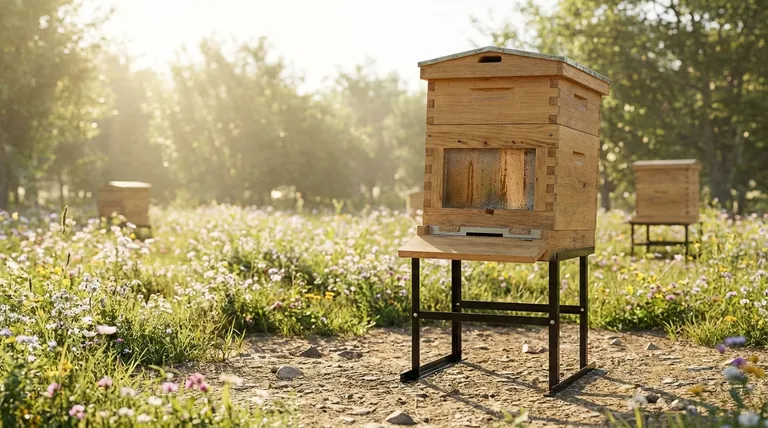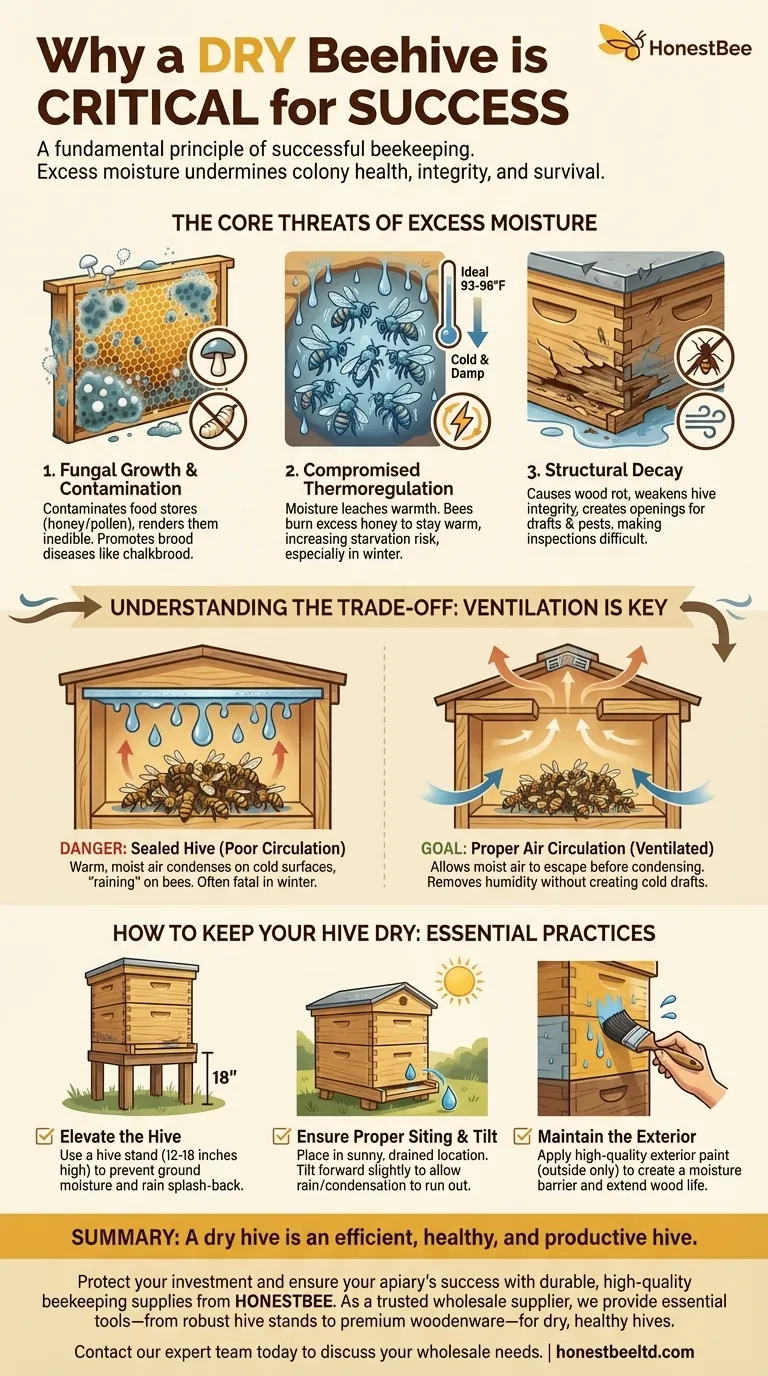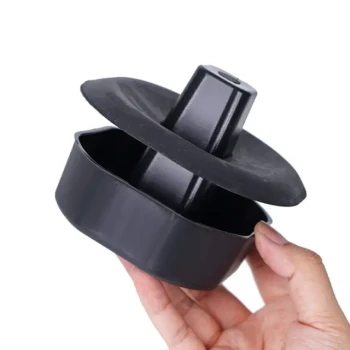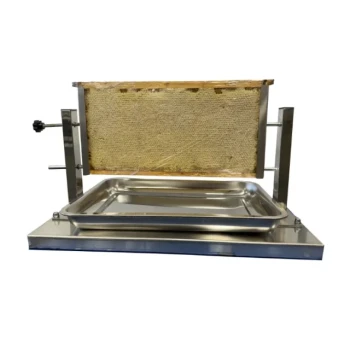Keeping a beehive dry is a fundamental principle of successful beekeeping. A damp environment is a direct threat to a colony's health, structural integrity, and survival, as it promotes disease, compromises temperature regulation, and accelerates the decay of the hive itself. Excess moisture forces bees to expend critical energy fighting the cold and dampness rather than focusing on their essential tasks.
A wet hive is an inefficient and unhealthy hive. Moisture directly undermines a colony's ability to regulate its temperature, fight off disease, and preserve its food stores, creating a cascade of problems that can lead to colony collapse, especially in winter.

The Core Threats of Excess Moisture
Understanding why dryness is critical requires looking at how moisture directly attacks the colony and its home from multiple angles. It is not merely a matter of comfort; it is a matter of survival.
Threat #1: Fungal Growth and Contamination
Excess moisture creates the perfect breeding ground for mold and fungi. This is not just an aesthetic problem; it is a direct threat to the colony's food supply and brood.
Mold can grow over frames of honey and pollen, rendering them inedible. This contamination forces the colony to discard valuable food stores that were gathered with immense effort, increasing the risk of starvation.
Furthermore, damp and stagnant conditions are ideal for pathogens that cause brood diseases like chalkbrood, where bee larvae die and become mummified by fungal growth.
Threat #2: Compromised Thermoregulation
Bees are masters of climate control, maintaining the core of their brood nest at a stable 93-96°F (34-36°C) regardless of the outside temperature. Moisture is the enemy of this process.
Water is highly effective at conducting heat away from a surface. When the interior of the hive is damp, it constantly leaches warmth from the bee cluster. The colony must burn through its precious honey stores at an accelerated rate just to generate enough heat to stay warm and keep the brood alive.
This energy expenditure is especially dangerous during winter. A colony that enters winter with ample honey stores can still starve to death if it has to burn all that fuel simply to fight off the chilling effect of internal condensation.
Threat #3: Structural Decay
Most beehives are made of wood. Constant exposure to moisture from the ground or persistent rain leads to wood rot, weakening the structure of the hive.
Rotting wood compromises the integrity of the hive boxes, bottom board, and cover. This can create unwanted openings that expose the colony to drafts and robbing insects, while also making inspections and hive manipulations difficult and damaging.
Understanding the Trade-off: Ventilation is Key
The goal is a dry hive, not an airtight one. A common and fatal mistake is to seal a hive too tightly in an attempt to keep it warm.
The Danger of a Sealed Hive
A colony of bees produces a significant amount of moisture through its own respiration and the evaporation of nectar into honey. In a poorly ventilated hive, this warm, moist air rises and hits the cold inner cover, where it condenses into water.
This condensation then "rains" back down on the bee cluster below. Being doused in cold water is often a death sentence for bees during winter, and it rapidly drains the colony's energy.
The Goal: Proper Air Circulation
Effective moisture management relies on proper ventilation. An upper entrance or a ventilated inner cover allows this warm, moist air to escape before it can condense.
This creates a slow but steady air exchange that removes excess humidity without creating a cold draft. It allows the bees to control their climate efficiently, keeping the hive interior dry and the cluster safe.
How to Keep Your Hive Dry
Implementing a few basic practices is essential for managing moisture and ensuring your colony has a dry, healthy home.
Elevate the Hive
Using a hive stand is the single most effective action you can take. Elevating the hive 12-18 inches off the ground prevents ground moisture from wicking up into the bottom board and protects it from rain splash-back.
Ensure Proper Siting and Tilt
Place your hive in a location that receives ample morning sun and has good drainage, so it never sits in a puddle.
Furthermore, give the hive a slight forward tilt (about half an inch). This ensures that any rain that drives onto the landing board or any condensation that forms inside runs out the entrance instead of pooling on the bottom board.
Maintain the Exterior
A solid coat of high-quality exterior paint on all outside surfaces of the hive (but never on the inside) provides a critical barrier against rain and moisture, significantly extending the life of your woodenware.
Making the Right Choice for Your Colony
Your strategy for moisture control should be proactive, not reactive. Different priorities may guide your specific actions.
- If your primary focus is winter survival: Prioritize top ventilation to allow metabolic moisture to escape, preventing deadly condensation from raining down on the winter cluster.
- If your primary focus is hive longevity: Use a sturdy hive stand and maintain a good coat of exterior paint to protect your wooden equipment from rot and decay.
- If your primary focus is overall colony health: Ensure the hive is sited in a sunny, well-drained location with a slight forward tilt to manage both internal and external moisture effectively.
Ultimately, a dry hive is an efficient, healthy, and productive hive.
Summary Table:
| Threat of Moisture | Key Impact on the Hive |
|---|---|
| Fungal Growth | Contaminates food stores, promotes brood diseases like chalkbrood. |
| Poor Thermoregulation | Forces bees to burn excess honey to stay warm, risking winter starvation. |
| Structural Decay | Causes wood rot, weakens hive integrity, and creates unwanted openings. |
Protect your investment and ensure your apiary's success with durable, high-quality beekeeping supplies from HONESTBEE.
As a trusted wholesale supplier for commercial apiaries and equipment distributors, we provide the essential tools—from robust hive stands to premium woodenware—that help you maintain dry, healthy, and productive hives season after season.
Contact our expert team today to discuss your wholesale needs and discover how our equipment supports superior hive management.
Visual Guide

Related Products
- Metal Bee Hive Stand Bee Box Stand for Beekeeping
- Metal Hive Feet Bee Hive Stand for Ant Protection
- Plastic Bee Hive Stand for Beekeeping
- Professional Ant-Proof Beehive Stand with Integrated Moat for Beekeeping
- Yellow Plastic Bucket Pail Perch for Beekeeping
People Also Ask
- Why is proper beekeeping equipment important? Essential for Safety and Hive Health
- Where is the best location for a bee hive? Maximize Colony Health & Honey Production
- How does climate influence the choice of hive for beekeepers? Optimize for Moisture & Temperature Control
- What is the purpose of a hive stand, and why is it beneficial? Elevate Your Hive for Colony Health and Beekeeper Comfort
- Do I need a hive stand? Essential for Bee Health & Easier Beekeeping



















